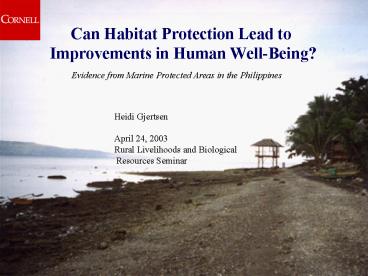Can Habitat Protection Lead to Improvements in Human WellBeing - PowerPoint PPT Presentation
1 / 23
Title: Can Habitat Protection Lead to Improvements in Human WellBeing
1
Can Habitat Protection Lead to Improvements in
Human Well-Being?
Evidence from Marine Protected Areas in the
Philippines
Heidi Gjertsen April 24, 2003 Rural Livelihoods
and Biological Resources Seminar
2
Introduction
- Causal relationships between poverty and
environment are unclear - Are there measures that can both alleviate
poverty and halt environmental degradation, or
are tradeoffs inevitable? - When are win-win situations possible?
- Analysis of marine protected areas in the
Philippines for coral reef protection
3
Outline
- Introduction
- Study Area
- Data
- Ecosystem Health Indicators (coral reef surveys
and interviews) - Poverty Indicators (child anthropometric data)
- Environment/Poverty Outcomes
- MPA Design and Contextual Variables
(interviews) - Regression Analysis
- Conclusions
- Further Study
4
The Study Area
- Philippines is located in center of marine
biodiversity gt 400 species of hard corals, 1000
species of fish - Reef fisheries provide livelihoods for gt 1
million people and contribute 1 billion to
Philippine economy - Less than 5 of Philippine reefs in excellent
condition
5
Damage
Images from ReefBase (www.reefbase.org)
6
Poverty in the Philippines
- In 2001,
- 26 of population lives below national poverty
line - Infant mortality 31 per 1,000 live births
- 32 of children under 5 years old are
malnourished - (World Bank, 2002)
7
Marine Protected Areas (MPAs)
- MPAs can provide protection against destructive
fishing and overfishing, damage from divers,
boats - ? 500 MPAs in Philippines, representing variety
of designs and levels of enforcement - Only 20-25 of MPAs in Philippines are successful
(Crawford et al., 2000) - Can MPAs meet conservation objectives without
trading-off development objectives?
8
(No Transcript)
9
Coral Reef Surveys
Images from Remote Sensing Handbook for Tropical
Coastal Management http//www.unesco.org/csi/pub/s
ource/rs_plate_14.htm
10
Measuring Coral Reef Health
11
FishermenInterviews
Photo courtesy of Paulette Apurado
12
Ecosystem Health Indicators
13
Poverty Indicators
14
Comparing Coral Reef Health and Childrens Health
Figure 1 Scatterplot between CHUWTOT2 (change in
percent underweight children) and CHMORT (change
in percent coral mortality)
15
MPA Committee Interviews
16
MPA Management and Local Context Variables
17
MPA Management and Local Context Variables
18
(No Transcript)
19
Effect of MPA Design on Outcomes
20
Effect of MPA Design on Outcomes
Change in Predicted Probability of Improvement in
Resource Conditions Due to Change in Level of
Success Factors (1 standard deviation centered on
mean)
21
Conclusions
- No simple, mechanistic relationship between coral
reef health and childrens health --context
matters - Win-win situations are possible and some
instruments may increase this likelihood, e.g.
alternative income projects, paying patrollers - Other instruments may impede poverty alleviation
while having no positive effect on coral reefs,
e.g. large fines - In some cases, tradeoffs may be inevitable, e.g.
boundary demarcation
22
Further Study
- Investigate pre-MPA to 2002 time period
- Use factor analysis to combine several indicators
into a single explanatory variable - Longer time-series and additional sites
23
Acknowledgments
AEM, Graduate School, Southeast Asia
Program Mario Einaudi Center for International
Studies
Miguel Castrence
Richard Pollnac R.A.s
Paulette Apurado Connie Miro Janet Moriles
Jonathan Apurado Martin Langevoord































